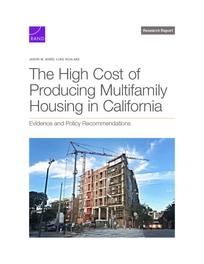The High Cost of Producing Multifamily Housing in California
Evidence and Policy Recommendations
ResearchPublished Apr 2, 2025
In this report, the authors present analyses of production cost differences among privately funded, market-rate apartments and publicly subsidized affordable apartments in California, Colorado, and Texas using a sample of cost data on more than 140 completed projects to identify drivers of higher costs in California policy reforms that can lower production costs and increase housing affordability in the state.
Evidence and Policy Recommendations
ResearchPublished Apr 2, 2025

Note: Several tables were revised on April 11, 2025, to correct some column headers.
In this report, the authors present analyses of production cost differences among privately funded, market-rate apartments and publicly subsidized affordable apartments in California, Colorado, and Texas using a sample of cost data on more than 140 completed projects. The report highlights large cross-state differences in production costs—for example, the average market-rate apartment in California is roughly two and a half times the cost of a similar apartment constructed in Texas on a square-foot basis—and regional differences within California, where costs in the San Francisco Bay area are roughly 50 percent higher than costs in San Diego. The report also focuses on the specific contributions of different cost categories to these overall differences and seeks to identify related policy reforms—such as requiring faster approval times, removing complex design requirements that do not relate to safety or habitability, and reducing mandatory fees assessed on new multifamily housing—that can lower production costs and increase housing affordability in California.
Funding for this research was provided by a generous gift from Dennis Wong of Verbena Road Holdings to the RAND Center on Housing and Homelessness. This research was conducted in the Community Health and Environmental Policy Program within RAND Social and Economic Well-Being.
This publication is part of the RAND research report series. Research reports present research findings and objective analysis that address the challenges facing the public and private sectors. All RAND research reports undergo rigorous peer review to ensure high standards for research quality and objectivity.
This document and trademark(s) contained herein are protected by law. This representation of RAND intellectual property is provided for noncommercial use only. Unauthorized posting of this publication online is prohibited; linking directly to this product page is encouraged. Permission is required from RAND to reproduce, or reuse in another form, any of its research documents for commercial purposes. For information on reprint and reuse permissions, please visit www.rand.org/pubs/permissions.
RAND is a nonprofit institution that helps improve policy and decisionmaking through research and analysis. RAND's publications do not necessarily reflect the opinions of its research clients and sponsors.